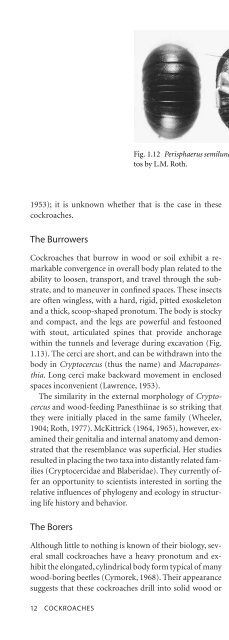Cockroache; Ecology, behavior & history - W.J. Bell
Cockroache; Ecology, behavior & history - W.J. Bell
Cockroache; Ecology, behavior & history - W.J. Bell
Create successful ePaper yourself
Turn your PDF publications into a flip-book with our unique Google optimized e-Paper software.
Fig. 1.12 Perisphaerus semilunatus female: dorsal, ventral, lateral, and nearly conglobulated. Photos<br />
by L.M. Roth.<br />
1953); it is unknown whether that is the case in these<br />
cockroaches.<br />
The Burrowers<br />
<strong>Cockroache</strong>s that burrow in wood or soil exhibit a remarkable<br />
convergence in overall body plan related to the<br />
ability to loosen, transport, and travel through the substrate,<br />
and to maneuver in confined spaces. These insects<br />
are often wingless, with a hard, rigid, pitted exoskeleton<br />
and a thick, scoop-shaped pronotum. The body is stocky<br />
and compact, and the legs are powerful and festooned<br />
with stout, articulated spines that provide anchorage<br />
within the tunnels and leverage during excavation (Fig.<br />
1.13). The cerci are short, and can be withdrawn into the<br />
body in Cryptocercus (thus the name) and Macropanesthia.<br />
Long cerci make backward movement in enclosed<br />
spaces inconvenient (Lawrence, 1953).<br />
The similarity in the external morphology of Cryptocercus<br />
and wood-feeding Panesthiinae is so striking that<br />
they were initially placed in the same family (Wheeler,<br />
1904; Roth, 1977). McKittrick (1964, 1965), however, examined<br />
their genitalia and internal anatomy and demonstrated<br />
that the resemblance was superficial. Her studies<br />
resulted in placing the two taxa into distantly related families<br />
(Cryptocercidae and Blaberidae). They currently offer<br />
an opportunity to scientists interested in sorting the<br />
relative influences of phylogeny and ecology in structuring<br />
life <strong>history</strong> and <strong>behavior</strong>.<br />
The Borers<br />
Although little to nothing is known of their biology, several<br />
small cockroaches have a heavy pronotum and exhibit<br />
the elongated, cylindrical body form typical of many<br />
wood-boring beetles (Cymorek, 1968). Their appearance<br />
suggests that these cockroaches drill into solid wood or<br />
Fig. 1.13 Adult Cryptocercus punctulatus. Photo courtesy of<br />
Piotr Naskrecki.<br />
soil because the shape minimizes cross-sectional area, reducing<br />
the tunnel bore and the force required to advance<br />
a given body weight. This morphotype is exhibited by<br />
the genus Colapteroblatta (Epilamprinae) (Roth, 1998a),<br />
as well as some species of Perisphaeriinae in the genera<br />
Compsagis, Cyrtotria, Bantua, and Pilema (Shelford,<br />
1908; Roth, 1973c). Compsagis lesnei typifies this type of<br />
cockroach (Fig. 1.14) and is a small (9.5 mm in length)<br />
African species found inside of tree branches (Chopard,<br />
1952).<br />
Desert Dwellers<br />
<strong>Cockroache</strong>s that live in the desert typically have morphological<br />
adaptations allowing for the conservation<br />
of water and for ease in negotiating their sandy environment.<br />
Adult females and nymphs are shaped like<br />
smooth, truncated ovals, with short, spined legs (e.g.,<br />
Arenivaga investigata—Friauf and Edney, 1969). The head<br />
is strongly hooded by the pronotum, and cuticular extensions<br />
of the thoracic and abdominal tergites cover the<br />
12 COCKROACHES


